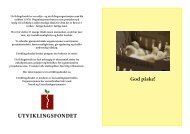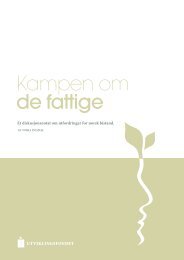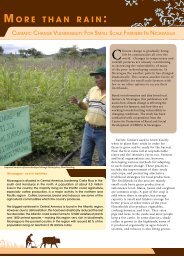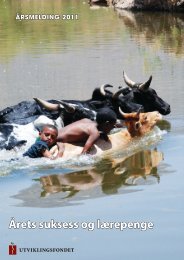Banking for the future: - Third World Network
Banking for the future: - Third World Network
Banking for the future: - Third World Network
- No tags were found...
You also want an ePaper? Increase the reach of your titles
YUMPU automatically turns print PDFs into web optimized ePapers that Google loves.
5Community seed bank in India. Photo: Green Foundationyield increase. Besides, modern varieties are genetically distinctfrom each o<strong>the</strong>r, uni<strong>for</strong>m and stable (i.e. <strong>the</strong>y fulfil <strong>the</strong> so calledDUS criteria of <strong>for</strong>mal breeding: distinct, uni<strong>for</strong>m and stable).Chapter II: Linking community seedbanks and Farmers’ RightsRegine Andersen 5 and Tone Winge 6Basically, realising Farmers’ Rights means enabling farmersto maintain and develop <strong>the</strong>ir crop genetic resources as <strong>the</strong>yhave done since <strong>the</strong> dawn of agriculture and recognising andrewarding <strong>the</strong>m <strong>for</strong> this indispensable contribution to <strong>the</strong>global pool of genetic resources. The realisation of Farmers’Rights is a precondition <strong>for</strong> <strong>the</strong> maintenance of crop geneticdiversity, which is <strong>the</strong> basis of all food and agriculturalproduction in <strong>the</strong> world. Since farmers are <strong>the</strong> custodians anddevelopers of crop genetic resources in <strong>the</strong> field, <strong>the</strong>ir rights inthis regard are crucial <strong>for</strong> enabling <strong>the</strong>m to continue this role.For this reason, Farmers’ Rights constitute a cornerstone in<strong>the</strong> International Treaty on Plant Genetic Resources <strong>for</strong> Foodand Agriculture, or <strong>the</strong> Plant Treaty. This treaty aims at <strong>the</strong>conservation and sustainable use of crop genetic resources,5 Dr. Regine Andersen is senior research fellow at <strong>the</strong> Fridtjof Nansen Institute anddirector of <strong>the</strong> Farmers’ Rights Project (www.farmersrights.org).6 Tone Winge is research fellow at <strong>the</strong> Fridtjof Nansen Institute, working <strong>for</strong> <strong>the</strong>Farmers’ Rights Project.<strong>the</strong>ir accessibility, and <strong>the</strong> sharing of benefits arising from<strong>the</strong>ir use.Parties to <strong>the</strong> Plant Treaty recognise <strong>the</strong> enormouscontributions that farmers have made, and will continue tomake, in conserving and developing plant genetic diversity,and in making this diversity available. According to <strong>the</strong> PlantTreaty, <strong>the</strong> responsibility <strong>for</strong> realising Farmers’ Rights restswith <strong>the</strong> national governments. The governments are free tochoose measures according to <strong>the</strong>ir own needs and priorities.Measures suggested in <strong>the</strong> Plant Treaty include protectingand promoting traditional knowledge relevant to cropgenetic resources, enabling farmers to participate equitablyin <strong>the</strong> sharing of benefits arising from <strong>the</strong> utilisation of suchresources, as well as in national decision making on relatedmatters. Fur<strong>the</strong>rmore, <strong>the</strong> treaty addresses <strong>the</strong> rights thatfarmers have to save, use, exchange and sell farm-saved seedand propagating material. We will have a closer look at <strong>the</strong>secomponents of Farmers’ Rights.Components of Farmers’ RightsProtecting traditional knowledge first and <strong>for</strong>emost meanstaking measures to halt this knowledge from disappearing.This can be done by collecting and documenting <strong>the</strong>remaining knowledge, sharing it to ensure continued use,teaching it to <strong>the</strong> younger generations, and encouraging itsuse. In some countries, stakeholders are concerned aboutprotecting traditional knowledge from misappropriation.There are several examples of how this can be done while at<strong>the</strong> same time ensuring that <strong>the</strong> knowledge can be shared, <strong>for</strong>example in <strong>the</strong> <strong>for</strong>m of catalogues.








